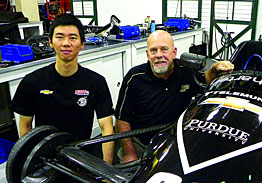Leading the charge in motorsports safety
White, an Indianapolis west sider, brings more than 30 years of experience in motorsports to the program. He started, as most Ben Davis High School boys did, he says, drag racing on Tuesday nights at Raceway Park in Clermont. Later he worked as a firefighter in the Wayne Township fire department for 10 years before becoming senior safety officer for Boehringer Mannheim, now Roche.
He received an invitation to train as a member of the fire crew at the Indianapolis Motor Speedway. One day, White says, he was sitting on the pit wall when car owner Dick Simon asked if he could look at a problem that none of his engineers could figure out. White identified the problem and fixed it. Simon responded, "Bring me your paycheck stub and I'll give you $10,000 more than whatever your employer is paying you. Come to work for me."

Di Xu, a graduate student in Mechanical Engineering, and Danny White.
And he did. White spent 20 years in Champ Car, the governing body later known as Championship Auto Racing Teams (CART), and IndyCar. He also worked on the NHRA top fuel team of Kristin Powell, who earned the title of the World's Fastest Teenager.
It was the death of race driver Greg Moore in the 1999 CART season finale race that led White to leave the Player's Forsythe team and take a sabbatical from racing to work for then-Indianapolis Mayor Bart Peterson. Two years later, White returned to the sport, purchasing an Indy Pro Series (now Indy Lights) team with Taylor Fletcher as his driver.
White's extensive experience means he is often sought out to comment on driver and spectator safety. Features like SAFER barriers and Kevlar rope used as tethers to hold racing wheels in place have protected both drivers and spectators. One area needing improvement, White says, is fencing.
The death of race driver Dan Wheldon has prompted White to argue for better design of catch fences at racetracks. "Las Vegas Leading the charge in motorsports safety and Texas both have poles on the interior of the fence toward the driver," White says. "As a safety professional, I don't think that's the wisest choice."
He also advocates for research on using Kevlar in the construction of these fences. "If Kevlar rope is that strong, why aren't we considering its use as a primary catch fence?" White says.
White has dual appointments in EPICS and Chemical Engineering. In addition to leading the motorsports program, he also serves as director of race operations and chief steward for the evGrand Prix, an outgrowth of the Indiana Advanced Electric Vehicle Training and Education Consortium (I-AEVtec), which is developing degree and training programs for the electric vehicle industry.
The motorsports program recently launched an aerodynamics online course to give technicians, drivers and mechanics of IRL racing cars the background needed to keep their job skills up-to-date in a quickly changing environment. The course has 11 modules, each 90 minutes, that can be taken anywhere at any time.
